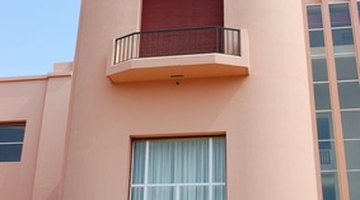How to Paint Synthetic Stucco
Synthetic stucco, or EIFS (exterior insulation finish systems), is a composite siding made up of layers of fiberglass mesh, foam insulating board and a final layer of synthetic stucco. Although the final layer is colored, it can still fade over time. The USDA Forest Service recommends that their synthetic stucco buildings be painted every five to seven years. Synthetic stucco has come under fire for causing water retention problems, where moisture wicks through the layers and becomes trapped, causing wood and drywall to rot. Sealing the stucco with water-based paint helps prevent moisture from entering, and allows it to evaporate if it does.

-
Caulk hairline cracks on the surface and around windows, doors and other trim with paintable silicone caulking. The Paint Quality Institute warns that power-washing before sealing cracks forces water under the siding, which can cause paint adhesion problems and interior rot and mold.
-
Clean the synthetic stucco siding with a power washer, using a 45-degree (white) tip. Narrower chiseling tips may damage synthetic stucco, which is softer than wood or traditional concrete stucco. If it is not heavily soiled, a garden hose with a spray nozzle attachment will work just fine. Allow the siding to dry for at least two days.
-
Repair damaged areas with synthetic stucco patching material, available at most home improvement stores. Apply the patching material to match the existing texture, and allow it to dry for at least eight hours.
-
Apply one coat of 100 percent acrylic primer with brush and roller or an airless sprayer.
-
Apply two uniform coats of 100 percent acrylic (water-based) paint, allowing at least eight hours of drying time between coats. Two coats of paint will last longer and look better than one thickly applied coat.
References
Tips
- You can skip the primer step if the stucco is not badly faded and discolored.
- If there are multiple hairline cracks on the surface, consider elastomeric paint. It is very thick, and unlike regular acrylic house paint, it fills hairline cracks. Good paint stores carry elastomeric paint. It must be rolled on or applied with a professional-grade airless paint sprayer.
Warnings
- Do not use any oil-based primer or paint on synthetic stucco. It will trap too much moisture from within the house, and tends to fade sooner than acrylic paint.
Writer Bio
Stevie Donald has been an online writer since 2004, producing articles for numerous websites and magazines. Her writing chops include three books on dog care and training, one of which won a prestigious national award in 2003. Donald has also been a painting contractor since 1979, painting interiors and exteriors.
Photo Credits
- House image by Gonçalo Carreira from Fotolia.com
More Articles



